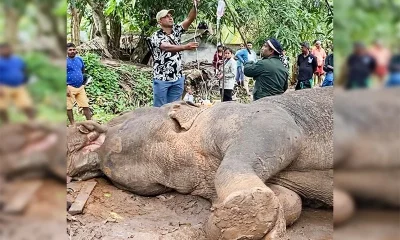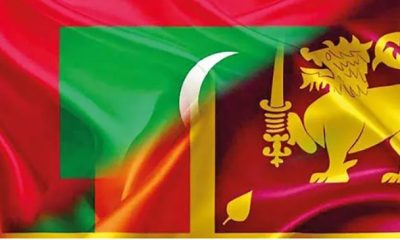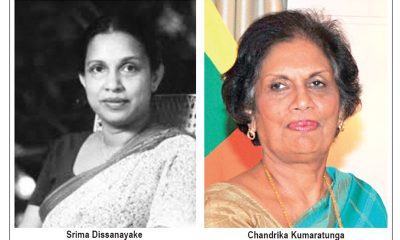News
‘Vulnerable’ South Asia least prepared to deal with urban heat: World Bank

South Asia is one of the regions most at risk due to extreme heat but the majority of its urban areas are ill-equipped to deal with the phenomenon, which is increasing in frequency, severity and complexity due to climate change.
This was stated in a new World Bank report which said that the region, home to a quarter of the world’s population, was accustomed to extreme heat, but rapid urbanisation and climate change were pushing the region’s limits of adaptation with lethal consequences.
The impacts of heat in South Asia are already emerging with over 3,600 heat-related deaths in India and Pakistan during the 2015 heat waves. More recently in 2022, at least one billion people in India and Pakistan experienced further record-breaking heat waves with temperatures reaching 51 degrees Celsius in some parts of Pakistan.
The report, ‘Urban Heat in South Asia: Integrating People and Places in Adapting to Rising Temperature’ said high-density living, along with low permeation of green and blue spaces, has created heat management challenges for a large number of communities in South Asia.
These environmental factors were important considering that heat adaptive measures, such as mechanical cooling through air conditioning, were rarely afforded in South Asia.In many South Asian communities, air conditioning use is impractical due to erratic electricity supply or affordability.
The report stated that across Pakistan, electricity demand often exceeded supply resulting in blackouts lasting three to four hours per day. These factors were not limited to low-income communities and extended across many urban communities in the region.
Urban heat is a rising risk across South Asian cities that is often underestimated and underreported. Unlike many other climate hazards, urban heat is a relatively predictable hazard that can be largely measured and protected against.
The report pointed out that the knowledge of urban temperatures in South Asia has been largely limited to satellite data or studies that have not accounted for spatial variability. This has limited the awareness and understanding of intra-urban heat differences in South Asian cities.
According to the report, South Asian cities face unique challenges, competing demands, and resource constraints, unlike anything in developed economies.Still, lessons could be learnt from outside the region to understand best practices and potential heat management improvements, the report suggested.
While explaining the complications of urban heat, the report said the heat has uneven spatial and social distributions, with wide variations in temperatures and adaptive capacities across buildings and cities around the world.
Urban areas often experience higher temperatures by absorbing more solar radiation than surrounding rural areas, a phenomenon called the urban heat island (UHI) effect, it stated.The existing heat risks in cities were amplified by warming temperatures from climate change as the global surface temperatures have risen 1.1C above pre-industrial levels. These global effects of climate change are further amplified at a local level through the UHI effect.
The report said that between 1950-2017, 60 per cent of the world’s urban population experienced warming twice as large as the global average, and by 2100, 25pc of the world’s largest cities could warm by 7C.
The report emphasised that future heat management efforts should be designed to address both social and spatial vulnerabilities.The cities need to map out overall heat vulnerability, including both heat risk factors, such as building density, materials and access to green/blue spaces, and demographic and socioeconomic determinants, such as income, age, education, gender, health, and social isolation.
There should be inclusive heat planning and policymaking processes to address thermal inequities, particularly in the most vulnerable communities and population groups, the report stated.The report urged policymakers in the region to ensure urban planning and development was adapted to higher temperatures in the face of climate change and the UHI effect.
The cities in the region should integrate people and place in managing the acute and chronic impacts of urban heat by better understanding the heat risks; garnering the necessary human, technical, and financial resources; and embedding urban heat resilience into planning and development processes, the report suggested.
News
Noritake Company Limited donates Rs. 20 million to the Government’s disaster relief programme

Noritake Company Limited of Japan has donated Rs. 20 million to the Government’s disaster relief programme.
The cheque was presented to Prime Minister Dr. Harini Amarasuriya by the Managing Director of Noritake Lanka Porcelain (Pvt) Ltd, Mr. Kenji Obara, at the Parliament Complex on 18 December.
Minister of Public Administration, Provincial Councils and Local Government Chandana Abeyratne, Director and General Manager of Noritake Lanka Porcelain (Pvt) Ltd, Ms. Sujatha Egodagedara, and Assistant General Manager Captain M. M. Athula Rohan Senarath also participated in the event.
[Prime Minister’s Media Division].
Latest News
GovPay Concludes 2025 with Rs. 2 Billion in digital transactions, marking a major milestone in Sri Lanka’s digital transformation

GovPay, Sri Lanka’s Government Digital Payment Platform concluded the year 2025 by surpassing Rs. 2 billion in total digital transaction value, marking a major milestone in the country’s digital transformation journey. Notably, GovPay doubled its collections from Rs. 1 billion to Rs. 2 billion in just 45 days, reflecting rapid adoption, growing public trust, and strong institutional uptake across the public sector.
Since its official launch on 07 February 2025, GovPay has processed over 69,000 digital transactions, enabling payments for 3,372 government services across 215 government institutions. This accelerated growth underscores the increasing reliance on secure, convenient, and transparent digital payment mechanisms by both citizens and government institutions.
Implemented under the strategic leadership of the Ministry of Digital Economy, the Information Communication Technology Agency of Sri Lanka (ICTA) in collaboration with LankaPay, GovPay has emerged as a key pillar of Sri Lanka’s national digital public infrastructure. The platform plays a critical role in advancing financial inclusion, improving service efficiency, and strengthening transparency in public service delivery.
A key milestone in 2025 was the launch of the Online Traffic Fine Payment System through GovPay on 10 April 2025. Since its introduction, the system has facilitated over 50,000 digital traffic fine payments, generating more than Rs. 66 million in revenue. The service is currently operational across the Western, Southern, Northern, North Western, and North Central Provinces, including the Southern, Katunayake, and Central Expressways. While the island wide rollout planned for December 2025 was postponed due to adverse weather conditions and disaster-related challenges, ICTA, in coordination with the Sri Lanka Police and with the support of LankaPay, has agreed to complete the nationwide rollout in January 2026, with a landmark launch in the Central Province.
GovPay has continued to expand its reach across local authorities, including Divisional Secretariats, Municipal Councils, Urban Councils, and Pradeshiya Sabhas, significantly enhancing access to government services in citizens’ day-to-day activities. The platform has enabled digital transactions for all local authorities in the Northern Province and all Divisional Secretariats in the Southern Province, with a national target to digitize all local authorities by 2026.
Institutions such as Kotelawala Defence University, Sri Lanka Police, the Department of Technical Education and Training, the University of Moratuwa, and the Sri Lanka Atomic Energy Board emerged as some of the highest contributors to GovPay in 2025. Strong adoption by the education sector in particular highlights the readiness of younger generations to embrace digital transformation and demonstrates the platform’s scalability and reliability.
Beyond routine government services, GovPay also supported national disaster response efforts. Since 30 November 2025, the platform facilitated digital donations to the Rebuild Sri Lanka Disaster Relief Fund, collecting almost Rs. 14 million across 909 transactions, including contributions from Sri Lankans living abroad, ensuring transparency and ease of contribution during a national emergency.
As GovPay continues to grow, ICTA is working on revamping www.govpay.lk with enhanced features to support institutional onboarding, service management, and reporting capabilities. With Rs. 2 billion in digital collections achieved within its first year of operation and the last Rs. 1 billion reached in just 45 days, GovPay stands as a strong testament to the impact of coordinated digital transformation, reinforcing Sri Lanka’s vision of achieving a USD 15 billion digital economy by 2030.
News
Swift restoration of Religious, Cultural and Archaeological sites damaged by the disaster

A discussion on the restoration of religious, cultural and archaeological sites affected by Cyclone Ditwah was held on Thursday (18) afternoon at the Presidential Secretariat under the patronage of the Minister of Buddhasasana, Religious and Cultural Affairs, Dr. Hiniduma Sunil Senevi, with the participation of the Most Venerable Mahanayaka Theras of the three Chapters and other religious leaders.
Addressing the meeting, the Minister stated that more than one thousand religious, cultural and archaeological sites across the country had sustained damage due to the disaster. He assured that prompt measures would be taken to commence restoration work and reinstate these sites to their original condition without delay.
The Minister further stated that all restoration work is expected to be carried out while preserving the historical and cultural authenticity of the sites, under the guidance of the Most Venerable Maha Sangha and other religious leaders, with the active participation of all relevant stakeholders.
The Secretary to the Ministry of Buddhasasana, Religious and Cultural Affairs, Prince Senadheera, noted that arrangements are currently underway to mobilize the required human resources and financial assistance for the restoration process. He also stated that steps have been initiated to recruit the necessary technical officers on a contractual basis to conduct technical assessments of the affected sites. In addition, plans are in place to involve officials of the Ministry as well as officers of its affiliated institutions in carrying out these restoration activities.
The Secretary to the Ministry further stated that generous financial contributions from donors are currently being received to the fund established under the Ministry of Buddhasasana, Religious and Cultural Affairs for the reconstruction of damaged religious places of worship.
The meeting also considered continuing the gathering as an interfaith committee to oversee the restoration activities. Accordingly, it was agreed that the progress of construction work would be regularly reported to the committee and that the committee would be entrusted with mobilizing support for the fund in a transparent manner, including assistance from foreign donors, international organizations, Buddhist organizations and other religious institutions.
It was noted that the Central Cultural Fund has identified eight sites that were severely damaged by the disaster and are difficult to restore through conventional construction methods, requiring the specialized expertise of archaeologists, mural conservation specialists, and architects. The cost of restoring these sites has been estimated at over Rs. 500 million.
It was further decided that the committee would meet once a month to review and discuss the progress of these restoration activities.
Religious leaders commended the Government’s intervention in providing relief to those affected by the disaster and in restoring livelihoods, expressing appreciation for the effective management of the response. They also praised the Government’s prompt action in initiating restoration work at damaged religious sites.
The event was attended by several eminent religious leaders, including the Registrar of the Asgiri Maha Viharaya, Venerable Dr. Medagama Dhammananda Nayaka Thero; the Registrar General of the Amarapura Siri Saddhammawansa Maha Nikaya, Venerable Balapitiye Siri Seevali Nayaka Thero; the General Secretary of the Sri Lanka Ramanna Maha Nikaya, Venerable Attangane Sasanarathana Nayaka Thero; the Chief Secretary of the All-Ceylon Shasanarakshaka Board, Venerable Professor Mugunuwela Anuruddha Nayaka Thero; and the Tri-Nikaya Maha Sangha, led by the Chairman of the National Bhikkhu Front, Venerable Wakamulle Uditha Thero.
Also in attendance were Hindu religious leaders, including Venerable Swami Aksharatmananda, representatives of the Catholic Church and the National Christian Council, including Father Alec Roy Samantha Fernando, All-Ceylon Muslim religious leaders, including the General Secretary of the Jamiatul Ulama Organization, Ash-Sheikh Arkam Nooramith, Deputy Minister of Religious and Cultural Affairs, Mohamed Muneer , as well as senior officials of the Ministry of Buddhasasana, Religious and Cultural Affairs and relevant line institutions.
-

 Features6 days ago
Features6 days agoWhy Sri Lanka Still Has No Doppler Radar – and Who Should Be Held Accountable
-

 Midweek Review3 days ago
Midweek Review3 days agoHow massive Akuregoda defence complex was built with proceeds from sale of Galle Face land to Shangri-La
-

 News2 days ago
News2 days agoPakistan hands over 200 tonnes of humanitarian aid to Lanka
-

 News2 days ago
News2 days agoPope fires broadside: ‘The Holy See won’t be a silent bystander to the grave disparities, injustices, and fundamental human rights violations’
-

 Latest News6 days ago
Latest News6 days agoLandslide early warnings in force in the Districts of Badulla, Kandy, Kegalle, Kurunegala, Matale, Nuwara Eliya and Ratnapura
-

 News3 days ago
News3 days agoBurnt elephant dies after delayed rescue; activists demand arrests
-

 News7 days ago
News7 days agoGovt. okays postgraduate medical training for Maldivian medical officers and dental surgeons
-

 Features6 days ago
Features6 days agoSrima Dissanayake runs for president and I get sidelined in the UNP













